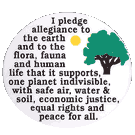1) Replace your incandescent light bulbs with compact fluorescent lights (CFLs). Look closely at labels when buying light bulbs. Those marked as CFLs last 10 times longer and use 66 percent less energy than incandescent bulbs while delivering the same light levels. CFLs also reduce the release of greenhouse gas emissions and are safer because they burn at a lower temperature (160° F or less) than incandescent and halogen lights, which can burn at temperatures up to 500° F.
2) Turn down the thermostat just three degrees in the winter and up three degrees in the summer. You can prevent the emission of nearly 1,100 pounds of carbon dioxide annually.
3) Inflate your car tires. When walking or biking isn't feasible, you can do something to better protect the Earth while driving. Take a step in the right direction by inflating your car tires. Pumping them up can improve your gas mileage by about 3.3 percent -- a savings of about 7 cents per gallon. It's the right thing to do for your wallet and the right thing to do for the Earth.
4) Turn down the hot water heater. Set your water heater to 130° F. While you're at it, turn down your house thermostat during the winter to 55° F when you go to bed or leave home. These simple actions can have enormous positive consequences, preventing the emission of more than 1,100 pounds of carbon dioxide over the course of the year, while cutting your energy bill by more than 10 percent. And that's just from you! Get your friends on board, and the benefits will multiply.
5) Choose your seafood wisely. The world's seafood will be entirely depleted by 2048, according to a report in the journal Science. That means the moment to do something about this is now. By buying and eating certain types of seafood, you can discourage harmful fishing practices and avoid the more depleted or threatened species. Take a look at Seafood Choices Alliance or Seafood Watch to make smart choices.
6) Purchase EnergyStar-labeled appliances. EnergyStar products are among the top 25 percent most efficient and can provide a 30 percent return or better through lower utility bills.
7) Wash and rinse in cold water. If everyone in the United States alone switched to cold water with their washing machines, we could save about 30 million tons of carbon dioxide each year -- and more than $3 billion in energy costs, collectively. And what's more? Cold water cleans your laundry just as well as hot water.
8) Buy locally produced meats and produce. Sounds like a good idea, but you don't know where to start? Just type in your zip code on Local Harvest's website to see a list of farms and farmers' markets close to home, as well as nearby restaurants committed to supporting their neighbors. Buying locally produced food cuts out the middlemen and the vast amounts of energy required to get your products onto store shelves. Most produce in U.S. supermarkets travels an average 1,500 miles before it is sold!
9) Drink more water from reusable glassware. It's great for your bank account, your health, and your planet.Water does the body good. The average American consumed more than 400 beverage bottles and cans in 2006, leaving behind wasted glass, plastic, steel, and aluminum. That adds up to excessive amounts of fossil fuels and hydropower for mining, processing, refining, shaping, shipping, storing, refrigerating, and disposing of those materials. Of course, changing your drinking habits both at home and at work is applicable to just about every other habit, as well. You've heard it before and you'll hear it again: Reduce, reuse, and recycle.
10) Walk, bike, and carpool. In the United States, the car represents one of the largest sources of greenhouse gas emissions. You can significantly reduce your emissions by commuting to work. Try combining trips to minimize emissions, which are greatest at the beginning of a journey before the engine has reached optimum temperature and efficiency. When purchasing your next car, make it a fuel-efficient one. Hybrid cars can get twice the fuel efficiency of the average new car, cut greenhouse gas emissions by half or more, and reduce urban air pollutants. Carpooling saves energy, cuts on additional pollution, and allows you to take a turn as a passenger instead of driving everyday. Car-sharing (not pooling) is available in numerous U.S. cities. Car-sharing enables you to rent a car just when you need it. Each car-share vehicle displaces four to eight privately held cars, requiring less parking area and creating less road congestion.(My brother has gotten rid of his car and does this.He LOVES it.) If you live within an hour's bicycle ride to the office (~10 miles), consider biking to work one or more days a week.
One little change can make a great impact.
Subscribe to:
Post Comments (Atom)







No comments:
Post a Comment